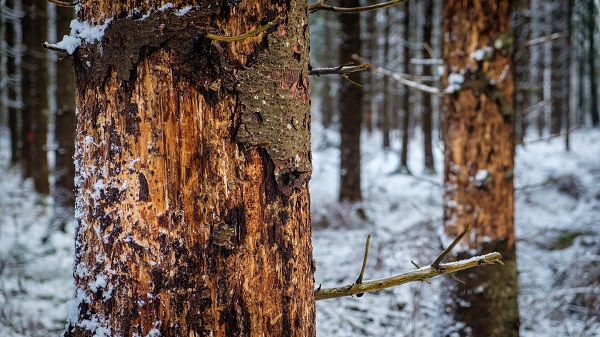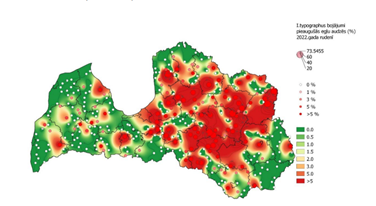State of Emergency to Control the Dangerous European Spruce Bark Beetle will also Affect Spruce Stands in Latvia’s State Forests
For the second time in the last 15 years, a state of emergency has been declared in some parts of Latvia, from 1 April to 30 June of this year for the control of the spread of the dangerous European spruce bark beetle (Ips typographus). In the municipalities where a state of emergency has been declared, the area of valuable spruce stands in the territory managed by JSC “Latvia's State Forests” (LVM) is slightly over 50 000 ha.
“Currently, damage caused by the European spruce bark beetle can be found across almost the entire territory of Latvia. There are regions where their proportion is smaller, for example in Kurzeme, while in Vidzeme and Latgale they numbers have increased. This is also confirmed by the National Forest Pest Monitoring carried out by the Latvian State Forest Research Institute “Silava” for 2022, with particular emphasis on the determination of the extent of fresh damage by the European spruce bark beetle in the autumn period, which indicates an increased risk in the spring of 2023,” says Edijs Leišavnieks, Head of Forest Protection and Fire Fighting at LVM.
Photo: The number of spruces freshly damaged by the European spruce bark in 2022
Along with the introduction of a state of emergency, valuable, undamaged spruce forests have been identified and three protection zones have been defined, in which economic activity restrictions are set. Tree felling restrictions in the vicinity of valuable spruce stands are set so that the smell, produced by conifers as a result of felling would not attract the European spruce bark beetle and would not pose a threat to valuable and healthy stands.
Anyone interested can see the location of the valuable spruce stands and the designated protection zones in the LVM GEO map browser https://lvmgeo.lvm.lv/ and in the LVM GEO Mobile app. The data is received on-line from the State Forest Service and is updated once a day.
It will affect production volumes
In the territory managed by LVM, in the municipalities designated as emergency, approximately one-fifth of the felling volume that was planned to be developed this year will be temporarily restricted.
“Due to certain restrictions, a total drop in production volume of 100 thousand cubic metres is expected. Also, an increase in the development costs by 0.3 million euros is expected, which is primarily related to the relocation of logging equipment. Moreover, it is expected that there will be an accumulation of fellings that are in bad and extreme logging conditions and the actual development of which is possible only in the summer months, because the winter months of the last years do not allow the successful development of these fellings without causing additional damage to the forest stand. Mainly they are spruce forests in peatlands,” says Ainārs Grīnvalds, Head of Production and Supply Chain of LVM Wood Products.
Also last year there were extensive damages caused by the European spruce bark beetle. In 2022, damaged trees in the forests managed by LVM were identified in the amount of 1 million cubic metres, of which around 850 thousand cubic metres were developed. The actual, rapidly increasing volume of damaged tree felling last year exceeded the forecast by almost half. This led to the need for additional logging capacity in damage-affected areas and a partial diversion of machinery from stand maintenance felling.
“Last year, the largest volume of tree fellings damaged by bark beetles was found and developed in the region of LVM Zemgale and Vidusdaugava, where the large volume was also affected by the spring winds of 2022. The forecasts for 2023 are similar, when around 800 thousand cubic meters could be developed in sanitary felling,” continues Ainārs Grīnvalds.
The last time when a state of emergency was declared for the control of the European spruce bark beetle in the country was back in 2007/2008. That year, a state of emergency was declared after one of the strongest storms of 2005, when the spruce bark beetle multiplied massively in fallen and broken conifers. To limit the growing population of bark beetles, similar restrictions were adopted, which are also currently defined in the Cabinet order.
Damage caused by the European spruce bark beetle
The European spruce bark beetle (Ips typographus) is the most destructive pest of Norway spruce (Picea abies) throughout its natural range in Europe and northern Asia. Hot, dry summers, as well as storms create favourable conditions for the spread of this pest when the bark beetle multiplies in wind-blown and broken fir trees. Often the damage caused by this pest exceeds by far that caused by a storm. The bark beetle attacks adult spruce trees – usually those with a diameter exceeding 20 cm. If there is a pine among several firs, then the pine may also be damaged. Up to 70 000 beetles can live in one adult spruce, which is about 40 cm in diameter. A tree can be destroyed by 3 000 to 5 000 beetles. At low pest intensity, a healthy tree can resist bark beetles, but if their number is significant, even healthy stands can be destroyed.




